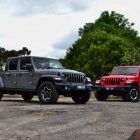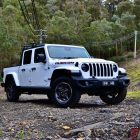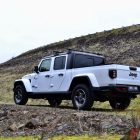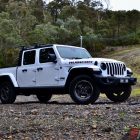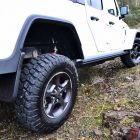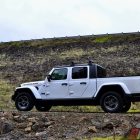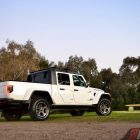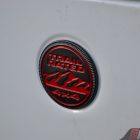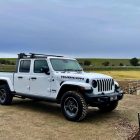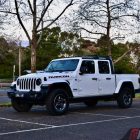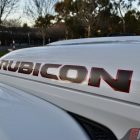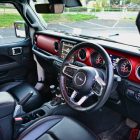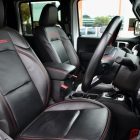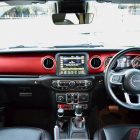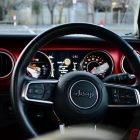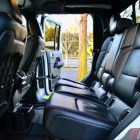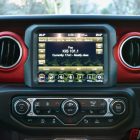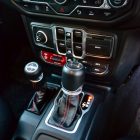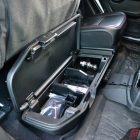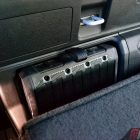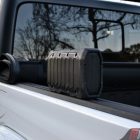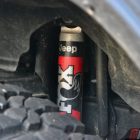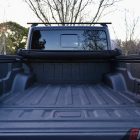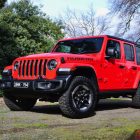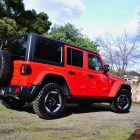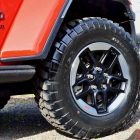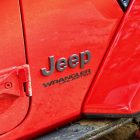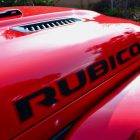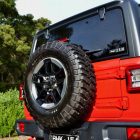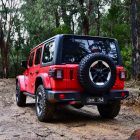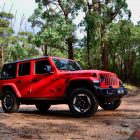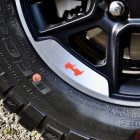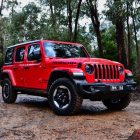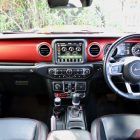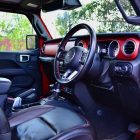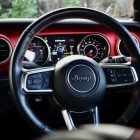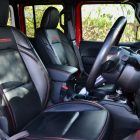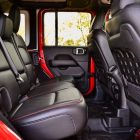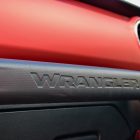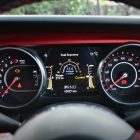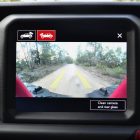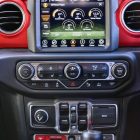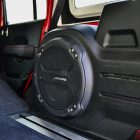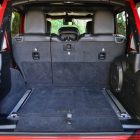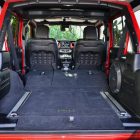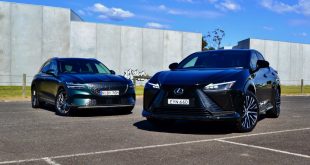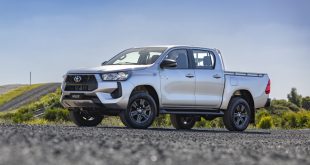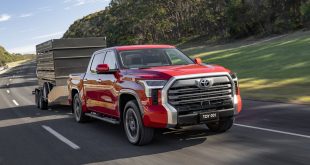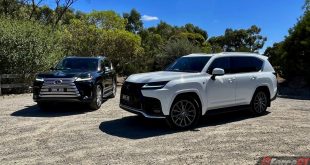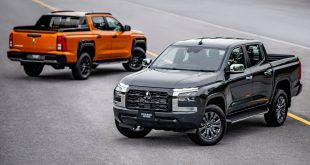If you’re in the market for an iconic off-roader, the Jeep Wrangler is about as iconic as an off-roader can get. But there’s now a derivative of the Wrangler that may appeal to keener drivers – and adventurers. The Wrangler has grown a tub to become a pick-up truck, better known as a ute here in Australia. Called the Gladiator, Jeep’s first ever ute launches as one of the largest in the segment.
Should you opt for the Wrangler, or is the Gladiator the better option? First, let’s look at the price. The Wrangler in the tested range topping Rubicon spec costs $90,450, while the Gladiator, also in the Rubicon spec as tested, is priced at $87,250. Both stickers exclude on-road costs.
There isn’t a big difference between the pair in terms of pricing, but they are quite different vehicles, most notably in the cargo area. The Wrangler is essentially an SUV with a fully enclosed (though removable) cargo space behind the second row seats with a massive capacity of 898 litres. The Gladiator has an open cargo tray behind the cabin cell that is good for a maximum payload of 693kg which is a little underwhelming in large ute standards.
If you carry many loose items, the secured cargo area of the Wrangler may be more suited for that. If your load is one big bulky piece, like a crate or dirt bike, the Gladiator’s open tray may be your only option. That said, the Wrangler’s entire rear section and the roof are removable, virtually removing the height restriction imposed by having the roof on. This allows you to carry tall items in the back.
Our Gladiator test vehicle comes optioned with a roll-up tonneau cover for the cargo tray, which when deployed provides some degree of cargo protection from the elements. However, it’s not motorised like in certain other utes, requiring manual deployment and retraction.
Then there’s the looks. The Wrangler’s utilitarian, two-box shape has defined the off-roader for generations. It’s one of the most recognisable vehicles on the road today. The Gladiator, while not yet as iconic (it’s a first generation model after all), brings about even more adventurism and road presence with its ute transformation of the basic Wrangler body. The Gladiator is a very long vehicle, measuring some 5.6 metres long compared to the Wrangler’s 4.8 metres. It looks like some sort of a special U.S. military transporter than a civilian ute. If you want to drive a head-turning ute, look no further than the Gladiator.
From the passenger cell forward, both vehicles are nearly identical. The doors and entire front section are shared between the two vehicles. This means they both get the trademark Jeep seven-slot grille flanked by round headlights, steel front bumper and fold-down windscreen. Both testers also sport “Rubicon” livery on either side of the clamshell bonnet, and share the same 17-inch black wheels wrapped in 32-inch BF Goodrich off-road tyres all around.
The interior is almost the same for the half twins as well. The off-road focused design employs ruggedised switchgear and chunky handles. The power window switches are located in the centre console rather than in the doors so they don’t get wet in deep water crossings. The USB ports and media jacks have plastic flaps over them for the same reason. There are even drainage plugs under the removable carpets, in case water do get in.
Both vehicles have been converted to right-hand-drive for the Australian market, with the dashboard flipped and the steering wheel on the right. The transmission orientation, however, has remained unchanged. As a result, the driver’s foot well is partially impeded by a bulge from the transmission housing and so there isn’t a foot rest for your left foot. Bugger.
The Gladiator has less rear passenger space than the Wrangler, as the rear seats are positioned further forward to accomodate the cargo tray in the back. We’re not talking a significant shortfall here, but rear passengers in the Wrangler do have more room to move about.
Both off-roaders have panels that are completely removable. The roof can be removed easily in minutes with the release of latches, but taking off the doors and rear section require removing some bolts with a special tool (supplied). Once everything is off, you get to do some fully open air driving. Beware though as it’s illegal to drive without doors in Australia!
As open as the cabin is, it’s assuring to see that occupants are still protected by a built-in roll cage, so if you do roll in either of these vehicles you should be able to climb out relatively unscathed. These Jeep models are probably safer in any low speed tip over than in a high speed crash anyway, as they only have four airbags – all of them for the front occupants. The lack of regard for rear passenger safety is questionable in this day and age. This is also why both models scored only a three-star ANCAP safety rating.
Complementing the passive safety features, or the lack of, both vehicles have stability control, forward collision warning, automatic emergency braking, blind spot monitoring, rear cross-traffic alert, roll mitigation and reverse view camera.
In terms of entertainment and connectivity, both models come equipped with an 8.4-inch touchscreen running the Jeep’s intuitive UConnect infotainment interface with built-in satellite navigation, wired Apple Carplay and Android Auto connectivity and DAB+ digital radio. Sound in both vehicles is played through a 9-speaker 552-watt Alpine premium sound system, with surround sound coming from the overhead sound bar and punchy bass served up by the subwoofer, boot-mounted in the case of the Wrangler, and behind the rear seats in the Gladiator. The latter takes audio playback a step further by including a removable wireless Bluetooth speaker that is stowed away neatly under the rear seat when not in use – very cool.
Jeep’s familiar 3.6-litre normally-aspirated petrol V6 engine can be found under the bonnet of both models. It’s getting a bit long in the tooth now but it still produces a healthy 209kW @ 6400rpm and 347Nm @ 4100rpm. Coupled to an eight-speed automatic transmission, it does a decent job around town, on the highway and off the beaten track.
The linearity in the V6’s power delivery and sharp throttle response is not what you’d normally find in modern turbo engines. With no lag or electric assistance trickery to deal with, what you get is tractable V6 power from the get-go and right through to the limiter. The near two tonne Wrangler accomplishes the sprint from rest to 100km/h in just 7.9 seconds (claimed), while the 200kg heavier Gladiator takes 8.5 seconds (claimed).
The drivetrain exhibits admirable refinement in both off-roaders, but that’s where the smoothness ends. Both vehicles are out-and-out four-wheel drives and they don’t drive like your regular family SUVs. The 32-inch BFGoodrich off-road tyres fitted to both models are noisy and rough on tarmac. The squared off body and large side mirrors found on both vehicles create quite a lot of wind noise at high speeds. Those uninsulated roof panels don’t help either in keeping noise out or absorbing cabin noise. Of the two, the Gladiator is the more civilised one thanks to a longer wheelbase which better absorbs roughness and deliver a more stable high speed ride.
The Wrangler’s steering feels vague on road, owing to its short wheelbase. Keeping the Wrangler straight at highway speeds can be quite a challenge as you have to constantly make steering corrections to keep within the lane. The turning circle is also large, making three-point turns a nightmare. The longer Gladiator is much worse, so don’t even try it.
On-road ride comfort in both vehicles is acceptable, with those large wheels soaking up road imperfections fairly well. Again, it’s the longer and heftier Gladiator that delivers a slightly smoother ride than the Wrangler.
That all said, you don’t buy one of these bad boys for road manners. Steer off the beaten track and they come into their own element. They become the ultimate off-road machines. Both models have identical 4×4 bits, and the Rubicon badging on both vehicles is not just for the sake, as it brings a host of hardcore dirt-kicking goodies on top of the already capable system on the lesser variants, including locking front and rear Dana 44 heavy-duty axles, electronic sway bar disconnect for maximum wheel articulation, Rock-Trac 4:1 low range transfer case with crawl ratio of up to 77:1 and steel off-road rock rails. These features complement high-range 4WD, hill-descent mode, winch-capable steel bumpers and underbody steel skid plates.
The Wrangler’s short front and rear overhangs allow for steep approach and departure angles of 36.5 and 31.9 degrees respectively, both are better than the Gladiator’s 40.7 and 25.1 degrees. The Wrangler’s shorter wheelbase also yields a tighter breakover angle of 18.4 degrees, compared to the Gladiator’s 21.2 degrees.
It’s no surprise that the Wrangler is better off-road than the Gladiator, given its shorter footprint. But both vehicles will take you far and deep into the bush thanks to their hugely capable 4WD hardware. As long as three wheels are in contact with the ground, there’s very little that these things are not able to plough through.
Back on the black top, the 3.6L V6 is not the most efficient mill out there. With the vehicles’ poor aerodynamics and the off-road tyres’ high rolling resistance, the average fuel economy at the end of our week-long test was an unimpressive 12.5L/100km for the Wrangler and 13.4L/100km for the Gladiator. Granted, with a large 81-litre tank they can travel the distance when filled up and they only need regular unleaded 91RON fuel.
Verdict
Few four-wheel drive vehicles out there have the presence, character and ruggedness of the Jeep Wrangler and Gladiator. They’re not just great off-road machines, they’re lifestyle statements. And ultimately it’s the kind of lifestyle that you want to live that dictates which of these vehicles you should get. The Wrangler is for you if serious off-roading and an enclosed cargo compartment are important factors. Else, the Gladiator is the cooler, more unique and more adventurous option.
| 2023 Jeep Wrangler Rubicon | 2023 Jeep Gladiator Rubicon | |
| Design and Comfort | 8.0 | 8.5 |
| Performance and Handling | 7.5 | 7.5 |
| Quality | 7.0 | 7.0 |
| Economy | 7.5 | 7.0 |
| Equipment and Features | 8.0 | 8.0 |
| Overall | 38/50 | 38/50 |
Pricing and Specification
| 2023 Jeep Wrangler Rubicon | 2023 Jeep Gladiator Rubicon | |
| Price (excl. on-roads): | From $90,450 As Tested: $96,175 Options fitted: Premium Paint ($1175) Rubicon Luxury Package including Leather Bucket Seats, Heated Front Seats & Steering Wheel, Body Colour Fender Flares, Trail Rail Management System ($1950) Trail-Ready Package including Integrated Off-Road Camera, Steel Front Bumper ($1850) | From $87,250 As Tested: $96,025 Options fitted: Lifestyle Adventure Group including Trail Rail System, Rubicon Luxury Package including Leather Bucket Seats, Heated Front Seats & Steering Wheel, Body Colour Fender Flare ($2535) Trail-Ready Package including Integrated Off-Road Camera, Steel Front Bumper ($2405) |
| Warranty: | 5 years, 100,000 km | 5 years, 100,000 km |
| Warranty Customer Assistance: | 5 years | 5 years |
| Service Intervals: | 12 months, 12,000km | 12 months, 12,000km |
| Country of Origin: | United States of America | United States of America |
| Engine: | 3.6-litre V6 petrol: 209.0kW @ 6400rpm, 347Nm @ 4100rpm | 3.6-litre V6 petrol: 209.0kW @ 6400rpm, 347Nm @ 4100rpm |
| Transmission: | 8-speed automatic | 8-speed automatic |
| Drivetrain: | Four-wheel drive | Four-wheel drive |
| Power-to-Weight Ratio (W/kg): | 104.9 | 95.2 |
| Combined Fuel Consumption (L/100km): | Claimed: 10.3/Tested: 12.5 | Claimed: 12.4/Tested: 13.4 |
| Fuel Capacity (L): | 81 | 81 |
| Body: | 5-door SUV | 4-door ute |
| Safety: |
|
|
| Dimensions (L/W/H/W-B): | 4,882/1,894/1,848/3,008 | 5,591/1,894/1,909/3,488 |
| Towing Capacity (kg): | Braked: 2,495/Unbraked: 750 | Braked: 2,721/Unbraked: 750 |
| Kerb Weight (kg): | 1,992 | 2,242 |
| Entertainment: |
|
|
 ForceGT.com Car News, Car Reviews, Video Reviews, Tuning and much more.
ForceGT.com Car News, Car Reviews, Video Reviews, Tuning and much more. 